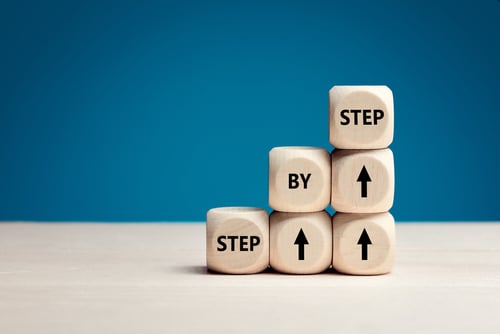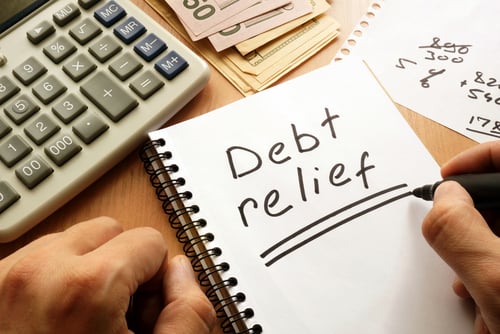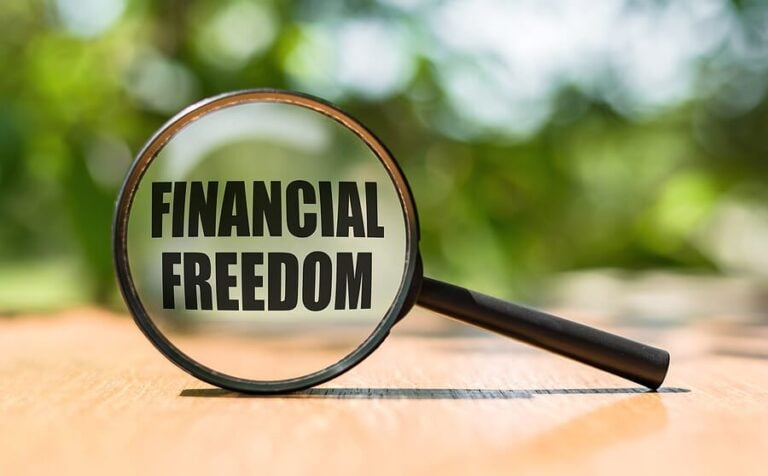Debt relief works by reducing, restructuring, or sometimes eliminating debts you owe so repayment becomes more manageable. This can be done through strategies like debt settlement, consolidation, or other programs designed to ease financial pressure.
For many people, the need for debt relief starts with high-interest credit cards, mounting late-payment notices, or collection calls that never seem to stop. These challenges make it difficult to catch up, even when you’re making payments regularly. That’s where debt relief programs step in — to provide a structured way forward.
In the sections below, we’ll explain the step-by-step debt relief process, the role of debt relief companies, and what you can expect if you decide this approach is right for you.
The Debt Relief Process
If you’re thinking about pursuing professional debt relief, here’s what the process could look like for you:
Step 1 – Onboarding & Assessment
First, you’ll share financial details with your chosen debt relief company, including your debts, income, and expenses. This information will be used to build a personalized debt relief plan that lays out the groundwork for getting you back on track. This is a great time to ask questions, share concerns, and solidify your financial goals.
Step 2 – Setting Up Your Debt Relief Program
Once you’re set up with a debt relief program, you’ll stop making payments to creditors directly. Instead, payments are going to go toward a dedicated account. Over time, this account will build leverage for negotiations.
Step 3 – Negotiation with Creditors
Debt relief companies will reach out to creditors on your behalf to negotiate lower balances, waive fees, or reduce interest rates. Negotiations can take months based on your creditors’ response times and cooperation. By working with a professional debt relief company, you can leave this step to the professionals and stay in touch for regular updates.
Step 4 – Settlement Offers & Approval
If your creditor agrees to a settlement, you can review and approve it before it is finalized. Then, the funds from your dedicated account will be released to pay off the negotiated amount.
Step 5 – Paying Off Settlements
Settlement payoffs can be made in either lump sum payments or installments, depending on the agreement. Some people prefer to make one large payment, if possible, to get the debt behind them. Others may rely on broken-up payments. After the balance is completely paid, the account will be marked as “paid” or “settled” by the creditor.
Step 6 – Program Completion & Debt Freedom
When all of your enrolled debts are resolved, your program ends. Some debt relief companies will provide you with additional coaching or tools to work toward rebuilding your credit. Late payments, a high debt-to-income ratio, and other factors can damage your credit and make it difficult to get approved for financial products like a mortgage or auto loan. By rebuilding your credit, you can work toward better approval odds and favorable loan terms like lower interest rates.
When to Start the Debt Relief Process
Knowing when to take the first step toward debt relief is just as important as understanding the process itself. Debt relief isn’t just for people facing bankruptcy–it’s a tool for many who are stuck in a cycle of minimum payments, rising balances, and overwhelming financial stress. Recognizing the early signs of debt problems can give you more options for long-term solutions.
Warning Signs You May Need Help
Signs that you may need help managing your debt include:
- You can only afford to make minimum payments each month.
- High interest rates keep your balances from actually going down.
- You get frequent collection calls and letters.
- You feel financially stuck without a clear path out of debt.
If these circumstances sound familiar to you, you may benefit from professional debt relief services. In terms of how debt relief companies work, we take the heavy lifting away from you, alleviating some of the stress associated with breaking free of overwhelming debt.
Why Timing Matters
If you act quickly when discovering you’re struggling with debt, you may have more options available. Quick action can also help prevent your debt from getting worse as interest and late payments grow. If you wait too long, you may lose some debt relief options and have a higher debt balance to deal with.
Exploring Different Types of Debt Relief Options
Keep in mind that there are different types of debt relief strategies. Some of the most common are debt consolidation, debt settlement, and debt management plans. Learn how each works to help decide what’s best for you.
Debt consolidation
Debt consolidation combines multiple debts into a single monthly payment, often with a lower interest rate. This can make payments more manageable with a set amount due one time per month. Plus, if you’re able to secure a lower interest rate, you could end up saving money in the long run.
Debt settlement
Debt settlement involves negotiating with creditors to accept less than what you owe. This can reduce your overall balance and help you get out of debt faster. However, this can have a temporary negative impact on your credit. So while it sounds great to have your debt balance drop, your credit score could, too.
Debt management plans
Debt management plans (DMPs), often offered through credit counseling programs, combine your debts into one payment that’s distributed to your creditors. Interest rates are usually reduced, making payments more manageable. So instead of making multiple payments to various creditors, you will make one payment to your counseling agency, which will disperse payments to your creditors based on the terms laid out in your DMP.
Does Debt Relief Work and When Does Debt Relief Not Work?
You may be wondering: “Do debt relief programs work?” Debt relief can work for the right person under the right circumstances. If you’re struggling with high-interest debts that you can’t lower with regular monthly payments, you may be a good candidate.
However, there are also times when debt relief doesn’t work. For example, it often doesn’t apply to debt types like mortgages, auto loans, and student loans. You also need to be committed to making regular payments until you fully complete the program. Debt relief takes time, so you’ll have to be patient and set realistic expectations for when you’ll be debt-free and how it will impact your credit health.
Ready for the Debt Relief Process?
In summary, debt relief works by following the right steps to identify your total debts and create a plan for paying them off. With professional help available, you can get support with negotiating balances, lowering interest rates, and transitioning from multiple due dates to one streamlined payment. If you’re ready to strengthen your personal finances by breaking free from debt, take the first steps now and see how United Settlement can help.

Steven Brachman is the lead content provider for UnitedSettlement.com. A graduate of the University of Michigan with a B.A. in Economics, Steven spent several years as a registered representative in the securities industry before moving on to equity research and trading. He is also an experienced test-prep professional and admissions consultant to aspiring graduate business school students. In his spare time, Steven enjoys writing, reading, travel, music and fantasy sports.





